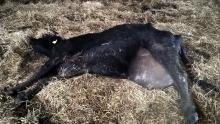One of the more frustrating problems faced by anyone caring for dairy cows is the ‘downer cow’. Defined most simply as a cow that remains recumbent for more than 24 hours; often very bright and alert with a good appetite, they seem very content! Often these cows do not walk off the farm, which is a demoralising result and costly too, with the difference between a cull value and fallen stock bill several hundred pounds, and for a very good cull over £1000.
Are we doing enough in our treatment and management of these? The prognosis is often drawn from the personal experiences of the farmer and vet involved, good enough perhaps, but what if we could draw on the experience of 200+ well recorded ‘downer cow’ diagnoses and treatments? This would be the sort of really useful ‘coal face’ research we would want to hear about, so, lucky it has been done then! And here are some highlights….
Primary causes (like milk fever, calving paralysis, ketosis, back and limb injuries) are often easily diagnosed and appropriate treatment begun, however, it is the nursing of the cow that most dictates ultimate success. Cows nursed to a ‘gold standard’ are 3.5 times less likely to get a secondary problem resulting in failure, and overall 8.5 times more likely to recover. Avoiding secondary damage (nerve, muscle and joint injuries) is crucial, only 14% of cows with secondary damage recovered, while 60% of those without secondary problems recovered within 7 days.
In total, 85% of the animals that were destroyed on farm failed to recover solely, or in part, due to secondary problems. Some of these are treatable and persistence with good nursing is key; surprisingly half of the cows that recovered (with good nursing) took >5 days to do so, but very few recovered after 12 days.
As vets we can help diagnose the problems and advise best treatment, so do call us to assess cows ASAP. For a full exam, we need to lift the cow fully, so please have the appropriate machinery i.e. hip hoist and wide cargo strap ready for the vet visit.
Some elements of gold standard nursing:
- Appropriate medication
- DEEP SOFT bedding, kept clean and dry
- Protected from weather
- Restricted from crawling more than 2-3m or off bedding
- Not lying on same leg >6 hours
- Access to fresh feed and water at all times
- Disinfection of teats twice daily, milk out only if leaking.


